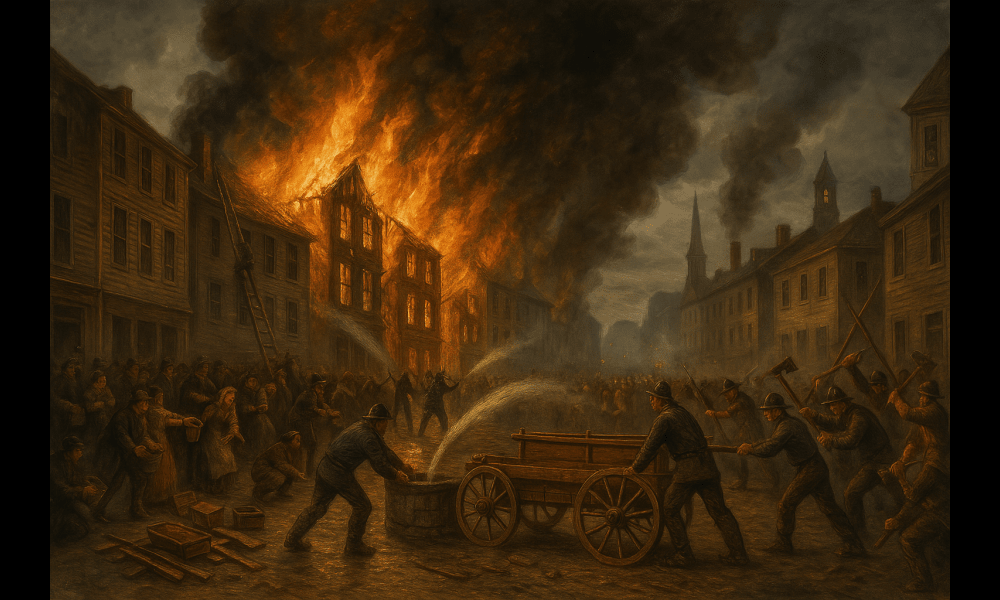The major fires of 1857, 1859, and 1861 were pivotal in Halifax’s fire service history. They exposed the fragility of the city’s firefighting system and directly contributed to sweeping changes across the Halifax Peninsula. Below is a detailed account of each incident and its aftermath.
1857 – The “New Year’s Day Fire” (January 1, 1857)
This fire began at the Halifax Hotel, located on the south side of Sackville Street between Granville and Barrington. It was discovered shortly after 3:00 a.m. in the central portion of the roof, and by 5:00 a.m. the entire hotel was ablaze. Fire crews responded but encountered low water pressure, and attempts to halt the fire’s spread were unsuccessful.
-
The fire destroyed the Halifax Hotel, spread eastward, consuming several buildings including the Royal Hotel, and damaged structures on Granville and Hollis Streets.
-
The Union Engine Company, Axe Fire Company, and Garrison firefighters worked to stop the flames. Still, their efforts were limited by equipment issues, including broken hose, and freezing weather hampered their progress.
Repercussions:
-
The event deeply shook public confidence.
-
A newspaper criticized the city's reliance on volunteers and stated that had the fire spread further, "it would have laid waste the most valuable portion of the city."
-
The fire exposed a lack of coordinated leadership, inconsistent water supply, and insufficient manpower. This fire is considered a turning point in the push toward reforming the fire service.
1859 – The Granville Street Fire / “The Great Fire” (October 15, 1859)
This devastating fire started in the early hours of the morning in a dry goods store at 152 Granville Street, quickly engulfing neighboring businesses.
-
Flames spread across Granville Street toward Barrington, consuming multiple blocks. Major businesses were obliterated, including retailers, warehouses, and law offices.
-
The Axe Fire Company, Union Engine Company, and military responded but were overwhelmed by the scale of the blaze. Hose issues, poor water supply, and late alarms again hindered operations.
Losses:
-
60+ buildings destroyed.
-
Hundreds unemployed.
-
Losses estimated at over £100,000, with limited insurance coverage.
Repercussions:
-
Called “The Great Fire,” this event was a major economic blow to the city.
-
It further undermined the city's fragmented fire response.
-
Led to a public inquiry into the performance of the fire companies and spurred calls for a professional fire service.
1861 – The Fire of January 12, 1861 (“The Last Straw”)
This fire broke out in the early morning hours at a cabinetmaker’s shop on Argyle Street, quickly spreading to Sackville, Grafton, and Brunswick Streets.
-
Entire blocks were wiped out.
-
Firefighters again struggled with hose malfunctions and poor coordination.
-
The Garrison stepped in once more to help contain the fire.
Repercussions:
-
The destruction and public outrage were immediate.
-
A committee of investigation formed and found that Halifax had become a “city without fire protection.”
-
Within weeks, the entire fire system was overhauled:
-
The Union Engine and Axe Fire Companies were dissolved.
-
Three new companies were created in 1861:
-
-
These companies marked the start of a more modern fire service with clearer organization, accountability, and equipment reform.
Summary of Citywide Repercussions (1857–1861)
-
Public Confidence Collapse: Repeated failures led citizens and officials to demand reform.
-
Firefighting Infrastructure Exposed: Inadequate water systems, outdated equipment, and poor inter-agency coordination were revealed.
-
Fire Service Reorganization (1861): The creation of new companies initiated a more formal, volunteer-based system and laid the groundwork for the professional Halifax Fire Department formed decades later.
These three fires collectively reshaped how Halifax approached fire safety and emergency response and were instrumental in transitioning from the colonial-era fire model to a more structured civic system.


